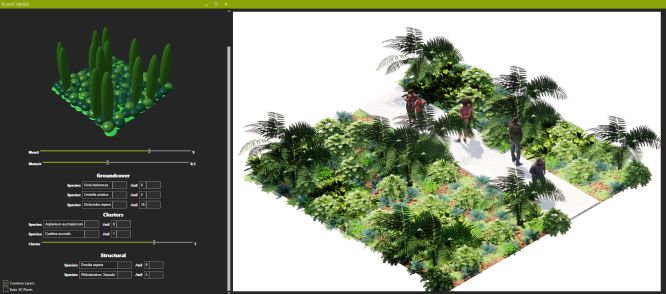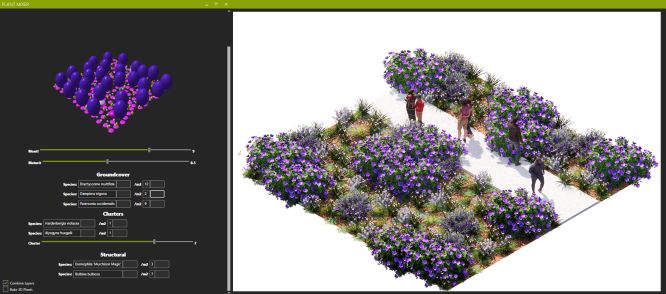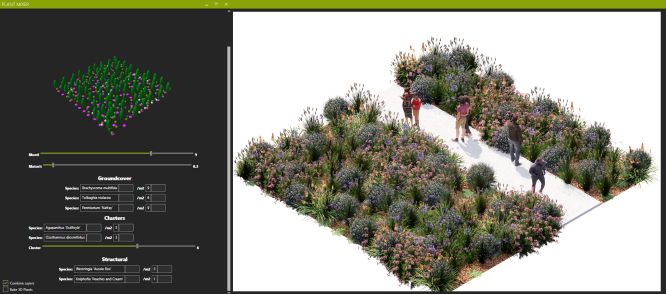Sowing virtual seeds

With advances in computing and 3D software, we can now create virtual plants that grow and change with the seasons.
Text and graphics by Michael G. White, Landscape Architect
Planting design has always been at the heart of landscape architecture, both an art and a mysterious science. The hand-coloured plans of Piet Oudolf, Gertrude Jekyll and others have a particular charm, speaking to their mastery of colour, form and seasonal change.
Today, much of this work takes place in the digital realm, in BIM models and spreadsheets. Many remain sceptical of the benefits these digital tools bring to our profession. Is it possible to turn these constraints into a new world of opportunity? In short, how can we use the power of computation and new digital tools to create beautiful, sustainable landscapes in the public realm?
CREATING A BOTANIC LIBRARY
The complex, living geometry of planting design has always created challenges in representation. Of the tens of thousands of species and cultivars used in landscape design, only a few dozen are commonly available as 3D representations. To record a single moment in the life cycle of a plant is a difficult task. To capture the full extent of seasonal change and growth is far more challenging. To begin, we must create a library of three-dimensional plant models and their growth habits and characteristics.
This process begins far from the screen, out in the parks and gardens where these plants can be found. First plant specimens are located and identified, noting species and maturity. Digital scans are taken of plant organs including seeds, leaves, bark and flowers. These will later be reconstructed into virtual plants using 3D software. For smaller or less complex plants, photogrammetry techniques may be used to capture both texture and geometry. No plants are harmed in the collection of these scans, taken in situ with standard camera equipment.
To create a series of models that include seasonal variation and growth requires repeat visits across multiple seasons.
Somewhat unexpectedly, creating great digital models requires being in tune with the physical landscape, watching as flowers bloom and fade away, or new species emerge from the soil to take over.
The experience of visiting wild landscapes to collect plant species for digitisation is also a process of education in our native ecology.
Armed with these realistic models, landscape architects can assemble planting designs by placing individual plants or by distributing them parametrically. Plants may be arranged according to site conditions or responding to design moves. With a planting design fully realised in 3D, designers can walk clients through planting designs, use virtual reality, render video, or even animate growth or view designs across different seasons.

DYNAMICS AND CHANGE
The phenomenal, majestic landscapes of the natural world we see around us were not designed. They are the result of rules and processes acting over time. In the future, instead of designing our landscapes with pencil and hand, we may grow them in a simulated site environment. In nature, plant communities form resilient layouts that maximise use of available resources through a process of competitive pressure. By abstracting these processes into simple algorithms, we can predict how vegetation communities may grow and change over time.
Simulating these processes could allow us to design vegetation systems that are better adapted to their site environment.
In an agent-based model, individual plants are represented in a computer simulation. These plant-agents are distributed across a virtual site either by random seeding or according to a specific designed layout. These virtual plants grow and develop over time, influenced by site conditions such as available sunlight and rainfall. Performance and growth data are collected from test beds and digitised herbarium records and used to inform the simulation.
Simulation as a design tool is well established in architectural and engineering practice, used for everything from daylight analysis to predicting structural failures. Planting design has lagged behind, a result of both the complexity of living systems, and a persistent separation of design and technical practice in landscape architecture. Developments in agricultural science and computing open up new possibilities for the simulation of plant growth and survival.




TOOLS BY AND FOR LANDSCAPE ARCHITECTS
Today, the landscapes of our cities are designed and documented in software created for engineers and architects. The relatively small landscape software market has not generated any significant rivals that have seen wide use. This software is designed to deal with static, non-living building components. To design with plants, our tools ought to be able to express their growth and change over time as well as interactions with each other and their environment.
Dr. Philip Belesky (RMIT) in 2013 lamented that “the potential of a computational landscape architecture is presently limited by a lack of computational techniques that focus on landscape systems. In the same way that architects have created tools to simulate how structural, solar, and thermal systems operate, we should develop tools that make hydrological, ecological, and other landscape systems active within the design process. These tools exist within scientific research and specialised software; the challenge is to adapt and integrate their capabilities into the computer-aided design programs that landscape architects already use.”
At Hassell, tools developed in-house are being used for rapid prototyping and communication of planting designs. The ability to quickly iterate plant mixes and receive immediate visual feedback in real time is a valuable tool for planting designers. Similarly, the ability to distribute thousands of plants parametrically allows changes without the laborious process of updating plans.

THE FUTURE OF DIGITAL PLANTING DESIGN
The application of complex computational methods to planting design is an unexplored frontier. In the same way that Frank Gehry, Zaha Hadid and Mark Foster Gage have created new architectural aesthetics empowered by computation, we too may use these tools to create new landscapes never before imagined. Computational planting design need not be limited to aesthetics. Appropriate selection and distribution of plant species in constructed landscapes can help to address problems such as water scarcity, rising temperatures and urban heat island effects.
These new methods have the potential to be transformative in our practice; however the creation of new design tools requires investment, time, and the collection of relevant data. A growing demand for resilience in the built environment, and the increased computing capabilities of a new generation of landscape architects and planting designers may lead the way forward.
This article appears in Pro Landscaper Magazine, February 2021.
